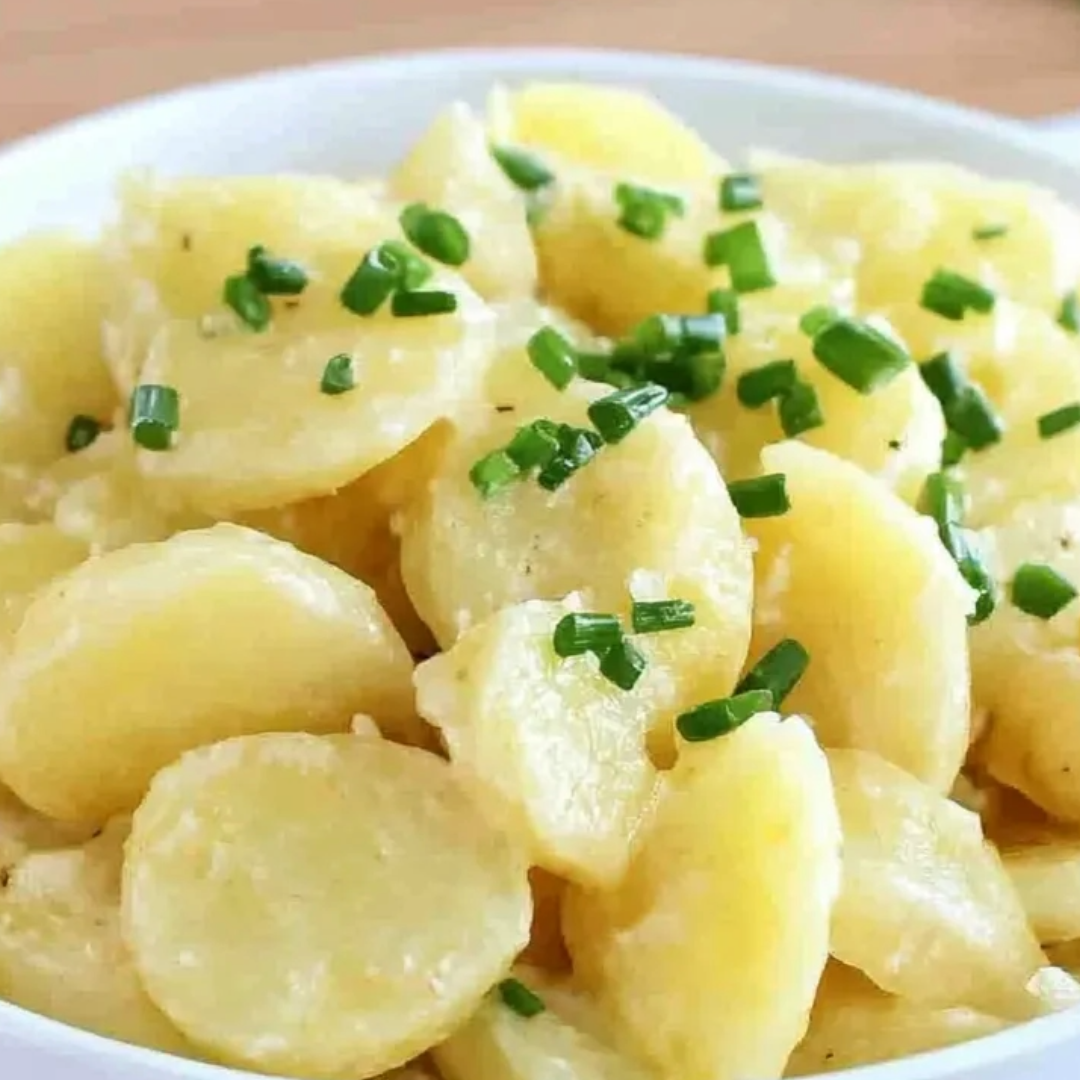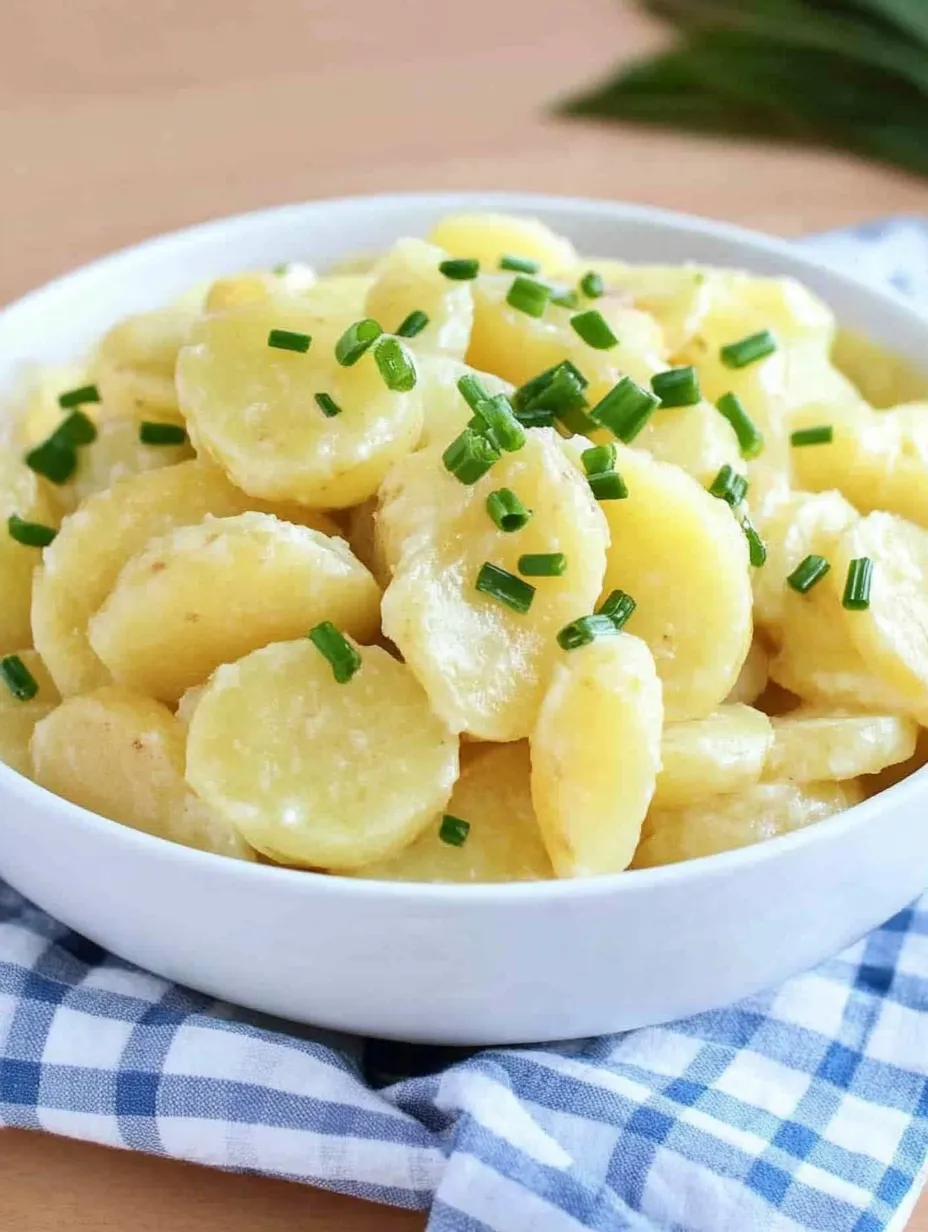 Pin it
Pin it
Schwäbischer Kartoffelsalat (German potato salad) offers an entirely different experience from its American mayonnaise-based counterpart, featuring tender potatoes bathed in a flavorful vinegar-oil dressing that creates a refreshingly tangy flavor profile. This authentic recipe from Southern Germany's Swabia region delivers the genuine restaurant-quality taste that potato salad enthusiasts seek – perfectly cooked Yukon Gold potatoes absorb a warm mixture of robust beef broth, vinegar, and delicate seasonings, mellowing into a harmonious balance of flavors as they rest. The key to this beloved dish lies not just in the quality ingredients but in specific techniques passed down through generations that transform simple components into a memorable culinary experience.
I grew up in southern Germany where this potato salad was a staple at family gatherings and restaurants alike. After moving to America, I spent years perfecting this recipe to match the unforgettable flavor I remembered from my childhood. This version combines my mother's traditional approach with techniques I observed in the best German restaurants, creating what I believe is the most authentic Schwäbischer Kartoffelsalat you'll find outside of Germany.
Ingredients and Selection Tips
- Potatoes: Yukon Gold potatoes provide the closest match to German varieties with their buttery flavor and waxy texture
- Beef Broth: Must be strong and hot when added; enhances this signature flavor foundation
- White Vinegar: Creates the distinctive tangy profile; traditional German Essig Essenz adds extra authenticity if available
- German Mustard: Mild German mustard (Düsseldorf style) contributes subtle depth without overwhelming
- Onions: Yellow onions softened in the hot broth mixture provide gentle crunch and aromatic flavor
- Oil: Neutral-tasting oil like sunflower or canola creates the necessary richness ("schmalzig" texture)
 Pin it
Pin it
Detailed Cooking Instructions
- Step 1:
- Begin by selecting 2 pounds of small Yukon Gold potatoes of uniform size, which ensures they'll cook evenly. Scrub them thoroughly but do not peel them, as cooking potatoes in their skins preserves their flavor and prevents them from becoming waterlogged during boiling.
- Step 2:
- Place the potatoes in a large pot and cover with cold water, adding 1 tablespoon of salt. Starting with cold water allows the potatoes to cook evenly from the inside out. Bring to a boil over high heat, then reduce to a simmer and cook until the potatoes are tender when pierced with a fork, approximately 15-20 minutes depending on size.
- Step 3:
- While the potatoes are cooking, finely dice one medium yellow onion, aiming for pieces about ⅛-inch in size. The fine dice allows the onions to soften appropriately in the hot broth while still maintaining a slight crunch in the finished salad.
- Step 4:
- Drain the potatoes in a colander and let them cool just until you can handle them, about 5-10 minutes. It's crucial to peel and slice the potatoes while they're still warm, as this is when they'll best absorb the flavorful broth mixture.
- Step 5:
- Using a paring knife or your fingers, carefully peel the warm potatoes. The skins should come off relatively easily. Once peeled, slice the potatoes into ¼-inch thick rounds and place them in a large glass or ceramic bowl. Avoid metal bowls which can react with the vinegar.
- Step 6:
- In a medium saucepan, combine 1 cup of strong beef broth, 3 tablespoons of white vinegar, 1 teaspoon of German mustard, 1 teaspoon of sugar, 1 teaspoon of salt, and ¼ teaspoon of white pepper. Stir to combine these ingredients, ensuring the mustard is fully incorporated into the liquid.
- Step 7:
- Add the diced onions to the broth mixture and quickly bring to a boil over high heat. The moment it reaches a boil, remove it from the heat. This brief cooking softens the onions slightly and helps them infuse the broth with flavor while taking the raw edge off their taste.
- Step 8:
- Immediately pour the hot onion and broth mixture over the sliced potatoes. The heat is essential as it allows the potatoes to absorb the flavorful liquid. Cover the bowl with plastic wrap or a plate and let it sit at room temperature for at least one hour. During this resting period, the potatoes will absorb the broth mixture and the flavors will begin to develop.
- Step 9:
- After the resting period, drizzle ⅓ cup of neutral oil (such as sunflower or canola) over the potatoes. Using a large spoon or spatula, gently fold the ingredients together, taking care not to break the potato slices. The oil creates the essential richness that authentic German potato salad requires.
- Step 10:
- Season with additional salt and white pepper to taste, then cover and refrigerate for at least 4 hours, preferably overnight. Before serving, allow the potato salad to sit at room temperature for at least 30 minutes, as cold temperatures dull the flavors. Give it one final gentle stir before transferring to a serving dish.
I learned these tips through years of watching my mother and grandmother prepare this dish. When I first tried making it on my own, I made the mistake of letting the potatoes cool completely before peeling and slicing them. The result was a salad that didn't properly absorb the broth mixture, missing that characteristic meld of flavors that makes this dish special.
 Pin it
Pin it
The first time I served this potato salad to American friends, they were surprised by the absence of mayonnaise but quickly became converts to this tangy, flavorful style. What makes this recipe truly special is its simplicity – it relies not on complicated techniques but on quality ingredients, proper timing, and patience. The transformation that occurs as the potatoes absorb the broth mixture and the flavors meld together is nothing short of magical. While many modern recipes attempt to rush this process or add unnecessary ingredients, this traditional approach honors the authentic flavors of southern Germany. Whether served alongside bratwurst at a summer barbecue or as part of a festive holiday spread, this Schwäbischer Kartoffelsalat connects you to generations of German home cooks who understood that sometimes the simplest preparations yield the most memorable results.
Frequently Asked Questions
- → What makes German potato salad different from American potato salad?
- German potato salad uses a vinegar-based dressing instead of mayonnaise and is typically served warm or at room temperature.
- → What is Essig Essenz and can I substitute it?
- Essig Essenz is a concentrated vinegar essence common in German cooking. If unavailable, you can substitute with additional white vinegar, though the authentic flavor will be slightly different.
- → Can I make this potato salad ahead of time?
- Yes! In fact, this salad tastes even better the next day after the flavors have had time to develop.
- → What type of potatoes work best for German potato salad?
- Waxy, yellow-fleshed potatoes like Yukon Gold are ideal because they hold their shape after cooking and don't fall apart when mixed.
- → Can I serve this potato salad cold?
- Traditional German potato salad is served at room temperature, but if refrigerated, let it sit out for at least 30 minutes before serving to bring out its full flavor.
